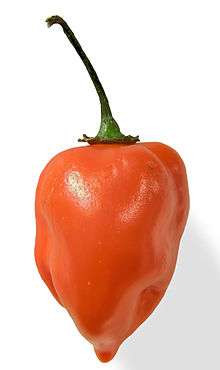Ghost pepper
The ghost pepper,[2][3] also known as bhut jolokia and it literally means ghost chili in Assamese[4] is an interspecific hybrid chili pepper cultivated in Northeast India.[5][6] It is a hybrid of Capsicum chinense and Capsicum frutescens and is closely related to the Naga Morich.[7]
| Ghost pepper | |
|---|---|
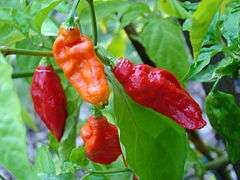 | |
| Hybrid parentage | Capsicum chinense × Capsicum frutescens |
| Origin | Assam, Nagaland and Manipur in Northeast India[1] |
| Heat | |
| Scoville scale | 1,041,427 SHU |
In 2007, Guinness World Records certified that the ghost pepper was the world's hottest chili pepper, 400 times hotter than Tabasco sauce. The ghost chili is rated at more than 1 million Scoville Heat Units (SHUs). However, in the race to grow the hottest pepper, the ghost chili was superseded by the Infinity chili in 2011 and Carolina Reaper in 2013.[8]
Etymology and regional names
In Assam[9], it is also known as bih zôlôkia ('poison chili'), denoting the plant's heat.[10] In Assamese bih means poison and zôlôkia means chili or pepper, making the literal translation poison pepper, obviously referring to its extreme spiciness.[11]
In Nagaland, one of the regions of cultivation, the chili is called Naga jolokia ('Naga chili'; also romanized nôga zôlôkia) and bhoot jolokia (also romanized bhût zôlôkiya).[10] There is some dispute as to whether the latter name means 'large-pod chili', 'ghost chili', or should be rendered Bhot jolokia ('Ghost chili').[10][12] This name is especially common in other regions where it is grown, such as Assam and Manipur.[10] Other usages on the subcontinent are Saga jolokia, Indian mystery chili and Indian rough chili.[10]
It has also been called the Tezpur chili after the Assamese city of Tezpur.[13] In Manipur, the chili is called umorok,[14] or oo-morok ('tree chili').
Scoville rating
In 2000, India's Defence Research Laboratory (DRL) reported a Scoville rating of 855,000 SHUs,[15] and in 2004 a rating of 1,041,427 SHUs was made using HPLC analysis.[16] For comparison, Tabasco red pepper sauce rates at 2,500–5,000, and pure capsaicin (the chemical responsible for the pungency of pepper plants) rates at 16,000,000 SHUs. In 2005, New Mexico State University's Chile Pepper Institute in Las Cruces, New Mexico,[17] found ghost peppers grown from seed in southern New Mexico to have a Scoville rating of 1,001,304 SHUs by HPLC.[5] Unlike most peppers, ghost peppers produces capsaicin in vesicles found in both the placenta around the seeds and throughout the fruit, rather than just the placenta.[18]
Characteristics
Ripe peppers measure 60 to 85 mm (2.4 to 3.3 in) long and 25 to 30 mm (1.0 to 1.2 in) wide with a red, yellow, orange, or chocolate color. The unselected strain of ghost peppers from India is an extremely variable plant, with a wide range in fruit sizes and fruit production per plant, and offers a huge potential for developing much better strains through selection in the future. Ghost pepper pods are unique among peppers, with their characteristic shape, and very thin skin.[19] However, the red fruit variety has two different fruit types, the rough, dented fruit and the smooth fruit. The images on this page show examples of both the rough and the smooth fruit. The rough fruit plants are taller, with more fragile branches, and the smooth fruit plants yields more fruit, and is a more compact plant with sturdier branches.[20] It takes about 7–12 days to germinate at 32–38 °C.
|
|
Uses
.jpg)
Ghost peppers are used as a food and a spice.[6] It is used in both fresh and dried forms, to "heat up" curries, pickles and chutneys. It is popularly used in combination with pork or dried or fermented fish. In northeastern India, the peppers are smeared on fences or incorporated in smoke bombs as a safety precaution to keep wild elephants at a distance.[21][22] The pepper's intense heat makes it a fixture in competitive chili pepper eating.[23]
Chili grenades
In 2009, scientists at India's Defence Research and Development Organisation (DRDO) announced plans to use the peppers in hand grenades, as a nonlethal way to control rioters by pepper sprays or in self-defence.[24][25] The DRDO said ghost pepper-based aerosol sprays could be used as a "safety device", and "civil variants" of chili grenades could be used to control and disperse mobs.[26] Chili grenades made from ghost peppers were successfully used by the Indian Army in August 2015 to flush out a terrorist hiding in a cave.[27]
Gallery
- Ghost pepper leaf, about 10-day-old plant
- Ghost pepper leaf, about 30-day-old plant
- Ghost pepper plant, 40 days old, grown in coco peat

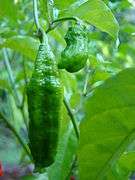
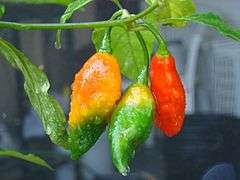
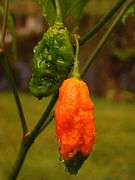
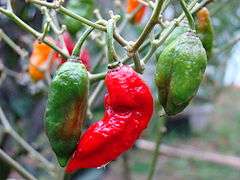
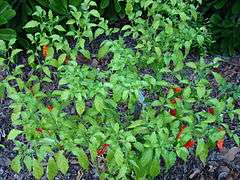
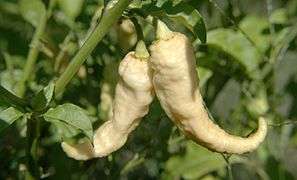 Peach ghost pepper
Peach ghost pepper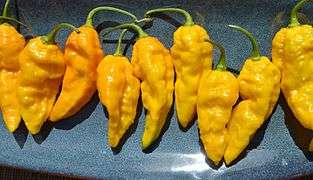 Yellow ghost pepper
Yellow ghost pepper Chocolate ghost pepper
Chocolate ghost pepper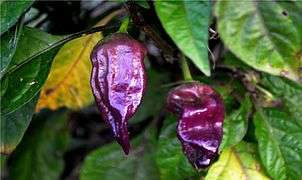 Purple ghost pepper
Purple ghost pepper- Red ghost pepper
References
- It is extensively cultivated in North Eastern Region of India especially in the states of Assam, Nagaland and Manipur. https://www.frontalagritech.com/chillies-peppers-herbs
- Gamillo, Elizabeth (3 August 2018). "Ghost peppers are saving U.S. grasslands—by scaring off hungry mice". Science. Retrieved 25 June 2019.
- Deepak, Sharanya (1 January 2019). "The Incredible Story of Bhut Jolokia: From Rural India to Dumb YouTube Stunts". Taste. Retrieved 25 June 2019.
- "Bih jolokia translates to 'poison chilli' in Assamese spoken in the state of Assam. Bhut Jolokia translates to 'Ghost chilli' maybe as a result of the ghostly bite.""Bih Jolokia - Hottest Bih Jolokia pods for you." www.pmrccorp.com. Retrieved 15 August 2020.
- Shaline L. Lopez (2007). "NMSU is home to the world's hottest chile pepper". Archived from the original on 19 February 2007. Retrieved 21 February 2007.
- "'Ghost chile' burns away stomach ills - Diet & Nutrition - NBC News". Associated Press. 2007. Retrieved 5 August 2007.
- Paul W. Bosland; Jit B. Baral (2007). "'Bhut Jolokia'—The World's Hottest Known Chile Pepper is a Putative Naturally Occurring Interspecific Hybrid" (PDF). Horticultural Science. 42 (2): 222–4. Archived from the original (PDF) on 23 September 2015. Retrieved 11 July 2014.
- "Hottest Chili". Guinness World Records. Retrieved 26 December 2013.
- "The origin of the Chili lies in the north-eastern of India, in the region of Assam." https://chili-plant.com/chilli-varieties/bhut-jolokia-chili/
- Raktim Ranjan Bhagowati; et al. (2009). "Genetic Variability and Traditional Practices in Naga King Chili Landraces of Nagaland" (PDF). Asian Agri-History. 13 (3): 171–180. Archived from the original (PDF) on 20 July 2011.
- https://smallaxepeppers.com/2019/05/01/how-hot-is-a-ghost-pepper/
- Anand, Manoj. "Assam's mirch will help make chilli grenade". The Asian Age. Archived from the original on 7 December 2009. Retrieved 24 April 2012.
- Dave DeWitt; Paul W. Bosland (2009). The Complete Chile Pepper Book. Timber Press. p. 158. ISBN 0-88192-920-4.
- Sanatombi K.; G. J. Sharma (2008). "Capsaicin Content and Pungency of Different Capsicum spp. Cultivars" (PDF). Not. Bot. Hort. Agrobot. Cluj. 36 (2): 89–90. ISSN 1842-4309.
- Mathur R; et al. (2000). "The hottest chili variety in India" (PDF). Current Science. 79 (3): 287–8.
- "Bih jolokia". 2006. Retrieved 12 December 2006.
- "NMSU: The Chile Pepper Institute - Home". The Chile Pepper Institute. Archived from the original on 20 November 2016. Retrieved 20 July 2012.
- Bosland, Paul; Coon, Danise; Cooke, Peter H. (June 2015). "Novel Formation of Ectopic (Nonplacental) Capsaicinoid Secreting Vesicles on Fruit Walls Explains the Morphological Mechanism for Super-hot Chile Peppers". Journal of the American Society for Horticultural Science. 140 (3): 253–256. doi:10.21273/JASHS.140.3.253.
- Barker, Catherine L. (2007). "Hot Pod: World's Hottest". National Geographic Magazine. 2007 (May). p. 21.
- Dremann, Craig Carlton. 2011. Redwood City Seed Company, Observations on the variations in the Bhut Jolokia pepper from seed reproduction growouts.
- Hussain, Wasbir (20 November 2007). "World's Hottest Chile Used as Elephant Repellent". National Geographic. Retrieved 21 November 2007.
- "Ghost Chile Scares Off Elephants". National Geographic News website. National Geographic. 20 November 2007. Retrieved 18 August 2008.
- Mary Roach (June 2013). "The Gut-Wrenching Science Behind the World's Hottest Peppers". Smithsonian Magazine.
- "Army's new weapon: world's hottest chili - Trends News - IBNLive". Ibnlive.in.com. 24 March 2010. Retrieved 6 November 2012.
- "South Asia | India plans hot chilli grenades". BBC News. 25 June 2009. Retrieved 11 April 2010.
- Bhaumik, Subir (24 March 2010). "India scientists hail 'multi-purpose' chillis". City of Westminster, England: BBC News. Retrieved 24 April 2012.
- "Army used 'chilly grenades' to flush out Pak terrorist Sajjad Ahmed from a cave". The Indian Express.
